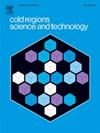Compaction mechanics of unsintered snow layers based on particle image velocimetry techniques
IF 3.8
2区 工程技术
Q1 ENGINEERING, CIVIL
引用次数: 0
Abstract
The knowledge of snow response under applied loads, particularly the deformation process during compaction, is important for avalanche modeling and cold region engineering. This paper is devoted to analyzing the deformation process of unsintered snow layers under compaction loads. An experiment framework that allows the observation of the unsintered snow deformation process on the symmetric plane of indentation is utilized along with the particle image velocimetry (PIV) technique. The experiment results show that during deformation, the snow particle velocity field can be categorized into four types: Type A, initial velocity field; Type B, vertical velocity field; Type C, shear band velocity field; and Type D, irregular velocity field. The shear band in loose snow beneath the compacted zone in Type C is the main difference between the deformation processes of snow samples with small and large initial depths, and it is also the key driver of the “egg shell” compaction effects in snow samples with large initial depths. The 150 mm depth sample exhibited the most regular compaction zone, with the Type B velocity field dominating for over 90 % of the duration. In contrast, the 300 mm depth sample displayed the most pronounced “egg shell” structure, with a 21.6 % density decrease between the surface and underlying layer. The findings in this study provide guidelines for developing construction methods and procedures for snow runways and roads, and can be utilized as a database for the validation of snow compaction numerical models.
基于粒子图像测速技术的未烧结雪层压实力学
了解积雪在外加荷载作用下的响应,特别是在压实过程中的变形过程,对雪崩建模和寒区工程具有重要意义。本文分析了未烧结雪层在压实荷载作用下的变形过程。利用粒子图像测速(PIV)技术,建立了在对称压痕平面上观测未烧结积雪变形过程的实验框架。实验结果表明,在变形过程中,雪粒速度场可分为四种类型:A型为初速度场;B型,垂直速度场;C型,剪切带速度场;D型为不规则速度场。C型压实带下松散雪的剪切带是小、大初始深度雪样变形过程的主要区别,也是大初始深度雪样“蛋壳”压实效应的关键驱动因素。在150 mm深度的样品中,压实带最为规则,B型速度场占主导地位,持续时间超过90%。相比之下,300 mm深度的样品显示出最明显的“鸡蛋壳”结构,表面和下垫层之间的密度下降了21.6%。本研究结果可为雪跑道和道路的施工方法和程序的制定提供指导,并可作为验证雪压实数值模型的数据库。
本文章由计算机程序翻译,如有差异,请以英文原文为准。
求助全文
约1分钟内获得全文
求助全文
来源期刊

Cold Regions Science and Technology
工程技术-地球科学综合
CiteScore
7.40
自引率
12.20%
发文量
209
审稿时长
4.9 months
期刊介绍:
Cold Regions Science and Technology is an international journal dealing with the science and technical problems of cold environments in both the polar regions and more temperate locations. It includes fundamental aspects of cryospheric sciences which have applications for cold regions problems as well as engineering topics which relate to the cryosphere.
Emphasis is given to applied science with broad coverage of the physical and mechanical aspects of ice (including glaciers and sea ice), snow and snow avalanches, ice-water systems, ice-bonded soils and permafrost.
Relevant aspects of Earth science, materials science, offshore and river ice engineering are also of primary interest. These include icing of ships and structures as well as trafficability in cold environments. Technological advances for cold regions in research, development, and engineering practice are relevant to the journal. Theoretical papers must include a detailed discussion of the potential application of the theory to address cold regions problems. The journal serves a wide range of specialists, providing a medium for interdisciplinary communication and a convenient source of reference.
 求助内容:
求助内容: 应助结果提醒方式:
应助结果提醒方式:


